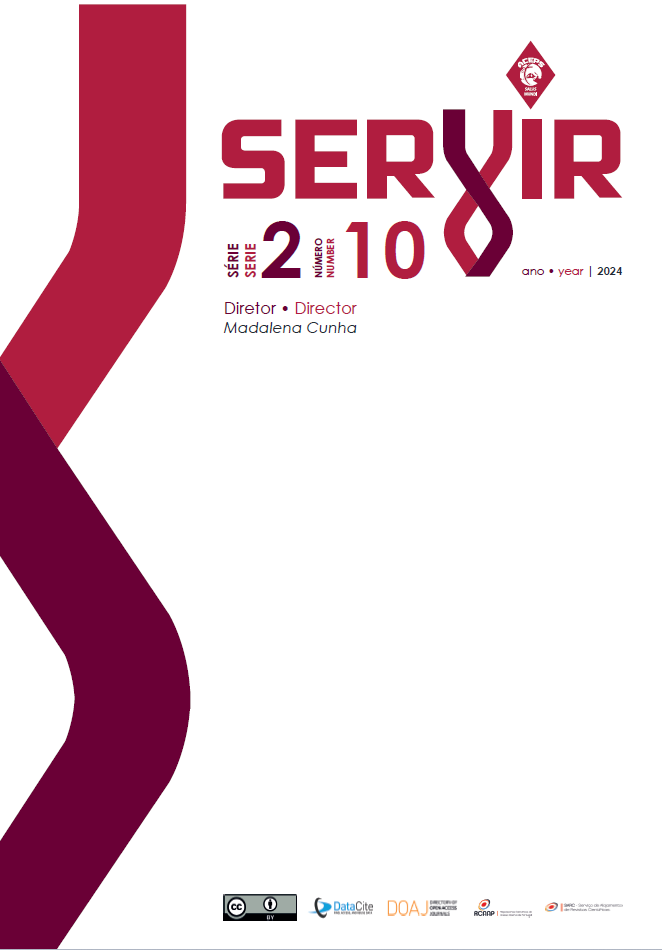Utilização de smartphones por estudantes de enfermagem na prática clínica
Protocolo de uma Scoping Review
DOI:
https://doi.org/10.48492/servir0210.35643Palavras-chave:
Aprendizagem, Tecnologia sem Fio, Estudantes de enfermagem, Smartphone, EnsinoResumo
Introdução: Os smartphones tiveram um grande impacto nos cuidados de saúde e na educação, incluindo a enfermagem, resultado da COVID-19. Tal conduziu a métodos de aprendizagem mais flexíveis e inovadores. No entanto, é necessário compreender o impacto e a extensão da utilização de smartphones no ensino teórico e clínico.
Objetivo: Explorar e mapear a evidência sobre como os estudantes de enfermagem utilizam os smartphones na prática clínica, centrando-se no seu papel como estratégia alternativa ou de apoio ao processo de ensino-aprendizagem.
Métodos: Orientado pela metodologia do Instituto Joanna Briggs para scoping reviews, serão pesquisadas bases de dados eletrónicas relevantes e literatura cinzenta, utilizando termos como "utilização de smartphones", "estudantes de enfermagem", "prática clínica" e "processo de ensino-aprendizagem". A revisão incluirá diferentes desenhos de estudo, incluindo investigação quantitativa, qualitativa e de métodos mistos e revisões sistemáticas.
Resultados: Espera-se que os resultados contribuam para explorar as formas multifacetadas como os estudantes de enfermagem utilizam os smartphones em contextos clínicos, centrando-se na identificação de potenciais benefícios, desafios e resultados associados à sua utilização.
Conclusão: Os achados poderão contribuir para melhorar os métodos de ensino, aumentar a participação dos estudantes e enfrentar os desafios da aprendizagem à distância, assim como identificar lacunas e orientar investigação futura. Este protocolo está registado no Open Science Framework.
Downloads
Referências
Hong, S., & Lee, J. Y. (2022). Evaluation of therapeutic communication education for nursing students based on constructivist learning environments: A systematic review. Nurse education today, 119, 105607. https://doi.org/10.1016/j.nedt.2022.105607
Kaminskienė, L., Järvelä, S., & Lehtinen, E. (2022). How does technology challenge teacher education? International Journal of Educational Technology in Higher Education, 19(1), 1–9. https://doi.org/10.1186/S41239-022-00375-1/METRICS
Kavanagh, J., & Sharpnack, P. (2021). Crisis in Competency: A Defining Moment in Nursing Education. OJIN: The Online Journal of Issues in Nursing, 26(1). https://doi.org/10.3912/OJIN.Vol26No01Man02
Khalil, H., Peters, M., Godfrey, C. M., McInerney, P., Soares, C. B., & Parker, D. (2016). An Evidence-Based Approach to Scoping Reviews. Worldviews on Evidence-Based Nursing, 13(2), 118–123. https://doi.org/10.1111/wvn.12144
Kim, J. H., & Park, H. (2019). Effects of Smartphone-Based Mobile Learning in Nursing Education: A Systematic Review and Meta-analysis. Asian Nursing Research, 13(1), 20–29. https://doi.org/10.1016/j.anr.2019.01.005
Levac, D., Colquhoun, H., & O’Brien, K. (2012). Scoping studies: advancing the methodology. Implementation Science, 5(69), 1–9. https://doi.org/10.1017/cbo9780511814563.003
Madden, M., Lenhart, A., Duggan, M., Cortesi, S., & Gasser, U. (2013). Teens and Technology. https://www.pewresearch.org/internet/2013/03/13/teens-and-technology-2013/
McGowan, J., Sampson, M., Salzwedel, D. M., Cogo, E., Foerster, V., & Lefebvre, C. (2016). PRESS Peer Review of Electronic Search Strategies: 2015 Guideline Statement. Journal of Clinical Epidemiology, 75, 40–46. https://doi.org/10.1016/j.jclinepi.2016.01.021
Padilha, J. M., Costa, P., Sousa, P., & Ferreira, A. (2024). Clinical virtual simulation: predictors of user acceptance in nursing education. BMC medical education, 24(1), 299. https://doi.org/10.1186/s12909-024-05154-2
Pedro, L. F. M. G., Barbosa, C. M. M. de O., & Santos, C. M. das N. (2018). A critical review of mobile learning integration in formal educational contexts. International Journal of Educational Technology in Higher Education, 15(1), 1–15. https://doi.org/10.1186/S41239-018-0091-4/METRICS
Peters, M. D. J., Godfrey, C., Mcinerney, P., Munn, Z., Tricco, A. C., & Khalil, H. (2020). Chapter 11 : Scoping reviews. In E. Aromataris & Z. Munn (Eds.), JBI Manual for Evidence Synthesis. JBI.
Peters, M. D. J., Marnie, C., Tricco, A. C., Pollock, D., Munn, Z., Alexander, L., McInerney, P., Godfrey, C. M., & Khalil, H. (2020). Updated methodological guidance for the conduct of scoping reviews. JBI Evidence Synthesis, 18(10), 2119–2126. https://doi.org/10.11124/JBIES-20-00167
Ravik, M., Laugaland, K., Akerjordet, K., Aase, I., & Gonzalez, M. T. (2024). Usefulness of pedagogical design features of a digital educational resource into nursing home placement: a qualitative study of nurse educators’ experiences. BMC Nursing, 23(1), 1–13. https://doi.org/10.1186/S12912-024-01776-5/TABLES/1
Tricco, A. C., Lillie, E., Zarin, W., Brien, K. K. O., Colquhoun, H., Levac, D., Moher, D., Peters, M. D. J., Ma, Q., Horsley, T., Weeks, L., Hartling, L., Aldcroft, A., Hons, B. A., Wilson, M. G., & Garritty, C. (2018). PRISMA Extension for Scoping Reviews ( PRISMA-ScR ): Checklist and Explanation. Annals of Internal Medicine. https://doi.org/10.7326/M18-0850
Downloads
Publicado
Como Citar
Edição
Secção
Licença
Direitos de Autor (c) 2024 Vitor Sérgio de Oliveira Parola, Susana Maria da Silva gaspar, Hugo Leiria Neves, Rui Filipe Lopes Gonçalves, Isabel de Jesus Oliveira

Este trabalho encontra-se publicado com a Licença Internacional Creative Commons Atribuição 4.0.
No intuito de promover a livre circulação do conhecimento, a Servir funciona em regime de acesso livre (open access). Todo o seu conteúdo está disponível e protegido sob a licença Creative Commons (CC BY 4.0).
A revista permite o auto-arquivo em repositórios institucionais de todas as versões, podendo ficar imediatamente disponíveis.


